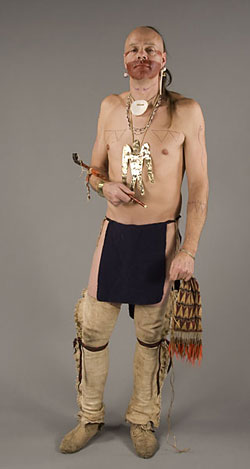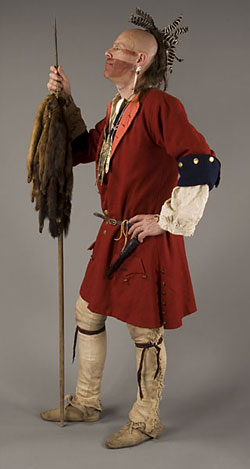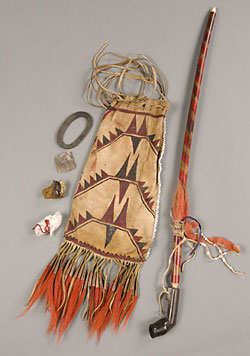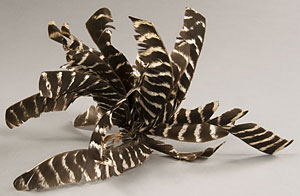




Advanced Search
Dress Up | 1st Person | African American Map | Now Read This | Magic Lens | In the Round | Tool Videos | Architecture | e-Postcards | Chronologies Turns Activities
Wôbanaki Men's Clothing from 1660Wôbanaki people did not have special clothing for sleeping. They slept in what seemed most suited for the season. In the winter this would mean wearing several layers to bed, and in the hot weather one might sleep without clothing. Hairstyles differed from group to group. In general, men living further north tended to keep their hair longer because the climate was cooler. Hairstyles would also change over the course of one’s life to reflect personal taste, or to signify alliance or mourning. Wôbanaki people believed it was a good idea to protect sensitive or vulnerable areas of the body, such as joints, any openings, the neck, ears and face, with jewelry, garters, and tattoos. By these means, they believed that dangerous energy or spirits could not enter their bodies. Jewelry with complicated patterns, reflective surfaces, and dangling and jangling pieces such as bells or metal cones, all helped to confuse harmful forces. Porcupine quill embroidery, beading, fringe, and ribbons might be added to the edges of clothing, both to offer protection and to create connections with desirable plants and animals. For instance, the edges of a breechclout might be decorated with ribbon, or the flaps on a pair of moccasins might be decorated with beads or porcupine quill embroidery. Among the numerous items available through trade in the 1660s were wool and linen cloth, ready-made shirts and coats, knitted wool hats and mittens, glass beads, brass kettles, paint pigments such as vermillion, and metal axe and spear heads and knife blades. Native American people in New England would trade with the French in New France or the English in the American colonies. Items they received typically came from England, France, Holland, or Spain. Go to interactive Flash version
Breechclout or BreechclothA breechclout, called “adhozoan”, is a strip of fabric or deerskin that goes between the legs and is held in place by a belt tied around the waist. The breechclout might be compared to modern-day shorts, underwear, or bathing suit. This man's breechclout is made of wool. Thunderbird PendantThis pendant is in the shape of a thunderbird or swallow, which are both considered by the Wôbanakiak to be powerful symbols. Swallows, too, are associated with thunder since they become more active before severe storms. The pendant was cut from a brass kettle.w
EarringsThese earrings are made of brass and shell. People often slept with their earrings on. Earrings are called “saksohanal”. Notice that this man hangs his pipe in his earring for convenience. The pipe is from Europe and is made of white clay.
Face PaintFace paint was used for a variety of reasons, including disguise or to convey a mood or emotion. This man wears red paint to show that he is feeling happy. Red was associated with life, victory, blood, war, or enthusiasm. Notice that he also wears a ring in his nose for decoration.
LeggingsThese are deerskin leggings, called “medasal”. They are tied to a belt at the waist to keep them up. Leggings were worn for warmth and to protect one's legs when walking through scratchy undergrowth. GartersThis man wears garters, called “kiganibial”, tied on just under his knees. They are made from wool yarn, using a technique called "fingerweaving". As the name suggests, fingerweaving is a way to weave by using just the fingers, instead of weaving on a loom. The garters help to keep the man's leggings in place. MoccasinsThese are summer-weight moccasins with a center seam. They are made from the hide of a white-tailed deer. The Abenaki call all kinds of shoes "mkezenal". The English adapted this word into “moccasin”. WaistcoatThis wool vest is called a waistcoat, sometimes pronounced, "weskit". The Abenaki called it a “silad”. It is a similar style to that worn by European men. “Indian waistcoats” like this were made by Europeans specifically for trade with Eastern Woodland peoples. It is interesting to note that the preferred color of wool cloth used by the Wôbanakiak for clothing was usually either red or blue. ShirtThis man's shirt, called a “wihibaks”, is made of linen. It is the same style worn by European men, but they would wear theirs tucked into their breeches.
Gorget & BeadsWhen worn by a British or French military officer, a "gorget" was a metal badge of office, signifying that the man was not a common soldier. The Wôbanaki people liked to wear gorgets simply for adornment. People cut up brass kettles received in trade to make their own gorgets, or they made them from shells, such as the one shown here. This man's beads are called "wampum," or in Abenaki, "wôbôbial". The purple beads are made from the thickest part of quahog clam shells found along the New England seacoast. The white beads are made from clam, whelk and other white shells.
Trade CoatWilliam and John Pynchon, English traders who settled Springfield and Northampton in the Connecticut River Valley of Massachusetts in the 1600s, provided this style of coat for trade with Wôbanaki people. This is a "sleeved waistcoat", also known as a "trade coat". As a large overcoat, it was called a "kchi pikizon". Some Native leaders purchased multiple coats and gifted them to relatives.
PipeThis pipe is for everyday use and shows personal touches (paint, a strand of beads, and a tuft of deer hair dyed red) added by its owner. Since the pipe's bowl is carved from stone, it is called a “senipôgan”. Tobacco PouchThe Abenaki word for tobacco is “odamô”, and a tobacco pouch is called an "odamôwinoda". This pouch is made of painted and beaded deer hide. It contains a metal striker, a piece of flint, a chunk of tree fungus, and a small bundle of tobacco tied up in cloth. When the striker and flint are struck together, they produce sparks. The sparks would light the tree fungus, which would then be used to light the tobacco in the bowl of the pipe.
RoachThis hairpiece is called a "roach". It is made of turkey wing feathers and it ties onto the hair. The Penobscot word for roach is "wesewal", which means "faith". A roach was an important and deeply meaningful ornament.
SpearA "rat spear" was used for hunting smaller animals such as rats, mink, or ermine. The spear head and shaft are made of metal and would have been received in trade. A stabbing tool like this is called an “astahigan”.
PeltsThis man hunts for a variety of fur-bearing animals to trade with the Europeans. This is a bundle of mink and white weasel (ermine) pelts.
|
| |
Home | Online Collection | Things
To Do | Turns
Exhibit | Classroom | Chronologies My
Collection
About This Site | Site Index | Site Search | Feedback









